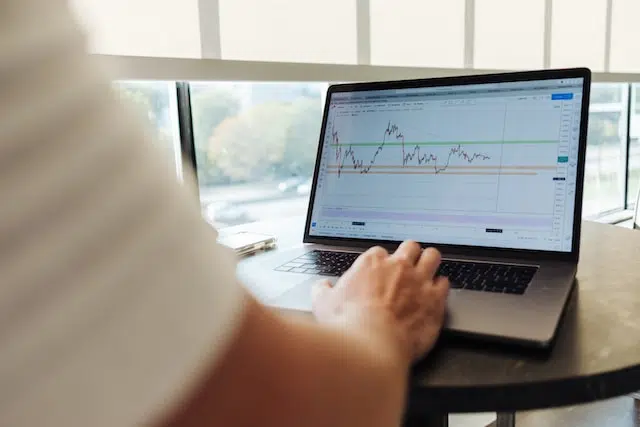CFD trading, or Contract for Difference trading, is a popular and dynamic method of investing in the financial markets. CFDs work by allowing traders to open a trade position on various financial instruments using contracts. These trades can be executed through platforms like Metatrader, providing traders with flexibility and convenience. With its potential benefits and unique characteristics, CFD trading, also known as Contracts for Difference, has gained traction among traders worldwide in the financial markets. CFDs work as a popular financial instrument, especially on platforms like MetaTrader.

Unlike traditional investing methods in financial markets, CFDs (financial instruments) in Metatrader allow traders to speculate on price movements without owning the underlying asset. This flexibility opens up a world of opportunities to trade various financial instruments such as stocks, commodities, indices, currencies, and securities. With the help of Metatrader, trading accounts can easily access these traditional trading options. By entering into a contract with a MetaTrader broker or exchange, traders can take advantage of both rising and falling markets. Trading accounts allow traders to buy and sell contracts.
One significant advantage for a trader in CFD trading is the ability to open positions with leverage on contracts in the underlying market, without having to pay a commission. Leverage allows traders to amplify their exposure to the market by only depositing a fraction of the total trade value. This is especially useful when trading contracts, as it allows traders to buy and sell with a smaller initial investment. In addition, the use of leverage can also increase commission earnings for traders, particularly for admirals who are experienced in navigating the market. When trading CFDs, a trader does not have to pay stamp duty fees for their trade positions like they would for traditional share purchases. This means that traders can save on commission costs when trading CFD contracts.
In the upcoming sections, we will explore the concepts of CFD trading in more detail and equip you with the knowledge needed to start your own journey as a trader. We will discuss trade positions, contracts, and commissions. So let’s dive in!
What are CFDs and How Do They Work?
Exploring the Meaning of CFDs
In the world of trading, a CFD trader frequently encounters Contract for Difference (CFD) contracts. These contracts often involve commission fees and are commonly used by admirals in the trading industry. But what exactly does it mean? Well, put simply, CFDs are financial instruments that allow traders, including admirals, to speculate on price movements without owning the underlying asset. This means that instead of physically buying or selling shares, for example, a trader enters into a contract with a broker to exchange the difference in price between the opening and closing positions in a cfd trade.
Understanding the Mechanics of CFD Trading
Now that we have a grasp on what CFDs are, let’s delve into how they work for traders. One key aspect of CFD trading is margin requirements. Unlike traditional investing, where a trader needs to pay the full value of an asset upfront, with CFDs, a trader only needs to deposit a fraction of the total trade value as margin. As a trader, engaging in cfd trade allows you to control larger positions with smaller amounts of capital.
Leverage is another crucial element in CFD trading. CFD trading refers to borrowing money from your broker to amplify your position as a trader. For instance, if you are a trader and your broker offers leverage at 1:10, it means that as a trader, for every dollar you invest, you can control ten dollars’ worth of assets. While leverage can magnify potential profits for a trader, it also increases risk exposure and potential losses.
Calculating Profits and Losses in CFD Trading
To better understand how profits or losses are calculated in CFD trading, let’s consider an example involving a trader. Suppose you, as a trader, believe that Company XYZ’s stock will rise in value over the next few days due to positive market news. As a trader, you decide to open a long (buy) position on 100 shares using a CFD contract.
If the stock price increases as anticipated and rises by $2 per share from your entry point when you decide to close your position, you, as a trader, would make a profit of $200 (100 shares x $2). On the other hand, if the stock price decreases by $2 per share, the trader would incur a loss of $200.
It’s important to note that CFDs are traded by traders on margin, and any profits or losses incurred by the trader are based on the full value of the underlying asset. Therefore, for a trader, gains or losses can be significantly higher than the initial margin deposit.
Weighing the Advantages and Risks of Trading CFDs
Trading CFDs offers several advantages that attract both experienced and novice traders. Firstly, as mentioned earlier, CFD trading allows the trader to speculate on price movements without owning the underlying asset. This means you can profit as a trader from both rising and falling markets.
CFDs provide access to a wide range of markets beyond traditional stocks for the trader. You can trade commodities like gold or oil, currencies in the foreign exchange market (Forex), indices representing baskets of stocks, and even cryptocurrencies like Bitcoin.
However, it is essential to consider the risks associated with trading CFDs. The leverage offered in CFD trading amplifies potential gains but also magnifies losses. It is crucial to have a clear risk management strategy in place and understand how much capital you are willing to risk before entering into trades.
Moreover, because CFD prices mirror the underlying asset’s price but do not involve physical ownership, there may be additional costs involved such as overnight financing charges or commissions imposed by brokers.
Exploring Different Types of CFD Trading Examples
Popular Markets for CFD Trading
There is a wide range of markets available for you to explore. These markets include stocks, indices, commodities, and currencies. Each market presents its own unique opportunities and challenges, making it essential to understand the intricacies of each type before diving in.
Let’s take a closer look at these different types of markets:
- Stocks: CFDs allow traders to speculate on the price movements of individual stocks without owning the underlying asset. This means you can potentially profit from both rising and falling stock prices. It’s important to keep an eye on company news, earnings reports, and other factors that may impact the stock’s value.
- Indices: Trading CFDs on indices allows you to gain exposure to a basket of stocks representing a particular market or sector. For example, you can trade CFDs on popular indices like the S&P 500 or FTSE 100. By analyzing overall market trends and economic indicators, you can make informed decisions about how an index might perform.
- Commodities: With CFD trading, you can also speculate on the price movements of various commodities such as gold, oil, or agricultural products like wheat or corn. Factors such as supply and demand dynamics, geopolitical events, and weather conditions can significantly influence commodity prices.
- Currencies: The foreign exchange (forex) market is one of the most popular choices for CFD trading. Traders can take advantage of currency fluctuations by speculating on pairs like EUR/USD or GBP/JPY. Economic data releases and central bank announcements play a crucial role in shaping currency values.
Impact of Market Conditions
Different market conditions require varying approaches when trading CFDs across these different types of instruments.
- Volatile Markets: During periods of high volatility where prices are experiencing significant fluctuations, short-term trading strategies may be more appropriate. Traders can take advantage of rapid price movements to generate quick profits.
- Trending Markets: In trending markets, where prices consistently move in one direction, trend-following strategies can be effective. By identifying and riding the trend, traders aim to maximize their gains as long as the trend remains intact.
- Range-Bound Markets: When prices are stuck within a defined range, range-trading strategies come into play. Traders look for opportunities to buy near support levels and sell near resistance levels, profiting from repeated price bounces between these boundaries.
Real-World Scenarios
To better understand how CFDs can be used in real-world scenarios, let’s consider a few examples:
- Hedging: Suppose you own a portfolio of stocks but anticipate a market downturn. Instead of selling your stocks and potentially missing out on future gains, you could use CFDs to hedge your positions by opening short trades on the corresponding stock indices or individual stocks.
- Leveraged Trading: CFDs offer leverage, allowing you to trade larger positions with relatively small amounts of capital. This feature can amplify both profits and losses. For instance, if you believe that gold prices will rise significantly in the coming months, you might decide to open a leveraged long position on a gold CFD.
Strategies Employed by Experienced Traders
Experienced traders often utilize specific strategies tailored to different types of markets when trading CFDs:
- Scalping: This strategy involves making multiple quick trades within short time frames to capitalize on small price movements. Scalpers aim to accumulate numerous small gains that collectively add up over time.
- Breakout Trading: Breakout traders focus on identifying key levels of support or resistance where significant price movements may occur when breached. They enter trades once the breakout occurs and ride the momentum generated by the breakout.
- Swing Trading: Swing traders aim to capture medium-term price movements by holding positions for a few days to several weeks. They analyze charts, technical indicators, and market trends to identify potential swing points where prices are likely to reverse or continue their current trend.
Benefits and Risks
It’s important to consider the potential benefits and risks associated with each type of instrument when trading CFDs:
- Benefits:
- Flexibility: CFDs offer the ability to profit from both rising and falling markets.
- Leverage: CFDs allow you to trade larger positions with a smaller initial investment.
- Diverse Markets: You can access various markets through a single trading platform.
- Risks:
- Volatility: The high volatility of some instruments can lead to significant price swings, resulting in substantial gains or losses.
- Leverage Amplification: While leverage can magnify profits, it also amplifies losses if trades move against you.
Understanding Limit and Stop Levels in CFD Trading
What are Limit Levels and Stop Levels?
Limit levels and stop levels are essential risk management tools that traders can utilize on CFD trading platforms. These features allow traders to automatically set profit targets (limit levels) and exit points to limit losses (stop levels) for their trades. By understanding how these tools work, traders can effectively manage their risk while maximizing potential gains.
Setting Profit Targets with Limit Levels
Limit levels play a crucial role in CFD trading as they allow traders to set profit targets for their trades automatically. When a trader enters a trade, they can specify the limit level at which they would like to close the position and secure profits. This feature is particularly useful for traders who may not have the time or availability to monitor their trades constantly.
For example, let’s say you believe that the price of a particular stock will increase from $50 to $60 per share. To capitalize on this potential gain, you enter into a long CFD position at $50 per share. By setting a limit level of $60, you ensure that your position will be automatically closed when the price reaches your desired profit target.
By utilizing limit levels effectively, traders can remove emotion from their decision-making process and stick to pre-determined profit objectives. This helps them avoid situations where greed may lead them to hold onto positions longer than necessary or miss out on taking profits due to indecisiveness.
Protecting Against Losses with Stop Levels
While limit levels focus on securing profits, stop levels act as safeguards against excessive losses in CFD trading. Stop levels allow traders to define predetermined exit points for their trades, ensuring that losses are limited within acceptable thresholds.
Imagine you enter into a short CFD position for a stock trading at $100 per share because you anticipate its value will decline further. To protect yourself from significant losses if the price unexpectedly rises instead, you can set a stop level at $105. If the price reaches this point, your position will be automatically closed, limiting your potential loss.
Stop levels are vital risk management tools as they help traders control their downside and prevent catastrophic losses. By setting predetermined exit points, traders can avoid emotional decision-making during volatile market conditions or when trades move against their expectations.
The Synergy of Limit Orders and Stop Orders
Limit orders and stop orders work hand-in-hand to manage risk effectively while maximizing potential gains in CFD trading. These order types allow traders to automate their entry and exit strategies based on specific price levels.
A limit order is an instruction to buy or sell a CFD at a specified price (or better). This order type enables traders to enter positions once the market reaches their desired price level. For example, if you believe that a stock currently trading at $50 per share will become more attractive at $45 per share, you can set a limit order to buy the CFD at $45.
On the other hand, a stop order is designed to trigger an automatic trade execution when the market reaches a specific price level. It helps protect against losses by allowing traders to exit positions before losses become too significant. For instance, if you are long on a stock priced at $100 per share but want to limit your potential loss if it drops below $95, you can place a stop order at $95.
By combining these two order types strategically, traders can effectively manage their risk exposure while capitalizing on profitable opportunities. This synergy empowers traders with greater control over their trading activities and enhances overall performance in CFD trading.
Adding Stop and Limit Orders for Effective Order Management
Stop and limit orders are essential tools in CFD trading that can help you manage risk, protect against potential losses, and secure profits. By understanding how to use these order types effectively, you can enhance your trading strategy and improve your overall performance.
Why Stop Orders are Crucial for Risk Management
Stop orders play a critical role in managing risk when trading CFDs. These orders allow you to set a specific price at which you want to exit a trade if the market moves against you. By placing a stop order, you can limit potential losses by automatically closing your position when the price reaches the predetermined level.
For example, let’s say you’re buying a stock CFD at $50 per share. To protect yourself from excessive losses, you can place a stop order at $45. If the price drops to or below $45, your position will be automatically closed, limiting your loss to $5 per share.
It’s important to note that stop orders do not guarantee execution at the exact specified price. In volatile markets or during fast price movements, slippage may occur, resulting in execution at a slightly different price than anticipated. However, using stop orders is still an effective risk management technique that helps prevent significant losses.
Utilizing Limit Orders for Profit Protection
In addition to managing risk with stop orders, traders can also utilize limit orders to secure profits. A limit order allows you to set a specific price at which you want to close a trade when it reaches a favorable level. This means that even if you’re not actively monitoring the market, your position will be automatically closed once the predetermined profit target is reached.
For instance, suppose you’ve bought a stock CFD at $100 per share and expect its value to increase significantly. You can place a limit order at $120 per share as your profit target. When the market reaches this level, your position will be closed automatically, securing a $20 profit per share.
By using limit orders effectively, you can take advantage of price movements without the need for constant monitoring. This feature is particularly beneficial for traders who have other commitments and cannot actively track their positions throughout the day.
Exploring Different Types of Stop and Limit Orders
CFD trading platforms offer various types of stop and limit orders to cater to different trading strategies and market conditions. Understanding these order types can help you make informed decisions when managing your trades.
- Stop Loss Orders: A stop loss order is designed to limit potential losses by closing a trade at a specific price level. It is commonly used to protect against adverse market movements.
- Trailing Stop Orders: Trailing stop orders are dynamic in nature and adjust automatically as the price moves in favor of your trade. They allow you to lock in profits while also giving room for further upside potential.
- Guaranteed Stop Orders: These orders provide an additional layer of protection by guaranteeing execution at the specified price, even during periods of high market volatility. However, they may come with additional costs or wider spreads.
- Take Profit Orders: Take profit orders enable you to close a trade once it reaches a predetermined profit level. They help secure gains without requiring constant monitoring or intervention.
Each order type has its own advantages and considerations, so it’s essential to familiarize yourself with them and choose the most suitable option based on your trading objectives and risk tolerance.
Strategies for Placing Effective Stop and Limit Orders
To maximize the effectiveness of stop and limit orders, it’s crucial to develop strategies that align with market conditions and your trading objectives. Here are some key steps to consider:
- Analyze Market Conditions: Before placing any stop or limit order, thoroughly analyze the market environment, including recent price movements, trends, support/resistance levels, and key news events. This analysis will help you determine appropriate price levels for your orders.
- Set Realistic Stop Loss Levels: Avoid setting stop loss levels too close to the current market price, as this can result in premature exits due to minor price fluctuations.
Leveraging Opportunities: Going Long vs Going Short in CFD Trading
Understanding Going Long in CFD Trading
In CFD trading, going long refers to buying an asset with the expectation that its value will rise. This strategy allows traders to profit from a rising market by purchasing contracts for difference (CFDs) at a lower price and selling them at a higher price. When you take a long position, you believe that the underlying asset’s value will increase over time.
Going long in CFD trading offers several advantages. Firstly, it provides opportunities for potential profits as the market moves upward. By identifying assets with strong growth potential through technical analysis or fundamental factors, traders can capitalize on these opportunities. Going long allows investors to benefit from dividend payments or interest earned on certain assets held for extended periods.
However, it is crucial to consider the risks associated with going long in CFD trading. While this strategy can yield substantial profits if the market moves favorably, there is also the possibility of losses if the market goes against your prediction. It is essential to carefully analyze market trends and indicators before entering a long position.
Exploring Going Short in CFD Trading
On the other hand, going short or selling in CFD trading involves profiting from a falling market. Traders who go short sell assets they do not own with the expectation that their prices will decline. They aim to buy back these assets at a lower price later and profit from the difference between their initial sale price and subsequent purchase price.
Going short presents unique benefits and risks compared to going long. One advantage is that it allows traders to potentially profit during bearish market conditions when asset values are declining. This flexibility enables investors to diversify their portfolios and take advantage of downward trends across various markets.
However, going short also carries inherent risks. If an asset’s value rises instead of falling as anticipated, traders may face substantial losses when they need to repurchase the asset at a higher price. Moreover, there is theoretically no limit to how much an asset’s value can increase, meaning potential losses in short positions are unlimited.
Factors Influencing Long or Short Decisions
Deciding whether to go long or short in CFD trading depends on various factors and market scenarios. Traders must carefully evaluate these elements before making investment decisions:
- Market Trends: Analyzing historical data and identifying prevailing trends can help determine whether the market is more suitable for going long or short.
- Economic Indicators: Keeping track of economic indicators such as GDP growth, inflation rates, and employment figures can provide insights into market conditions that favor either going long or short.
- Company Fundamentals: Assessing a company’s financial health, industry position, and growth prospects can guide decisions regarding long or short positions on its stock.
- Technical Analysis: Utilizing technical analysis tools like chart patterns, moving averages, and momentum indicators can assist in identifying optimal entry and exit points for both long and short positions.
By considering these factors collectively, traders can develop a comprehensive understanding of the market dynamics and make informed decisions about going long or short in CFD trading.
Strategies for Identifying Opportunities
Identifying opportunities to go long or short requires a combination of technical analysis skills and understanding fundamental factors affecting an asset’s value. Here are some strategies that traders employ:
- Trend Following: This strategy involves identifying established trends using moving averages or trendlines and entering trades in the direction of the prevailing trend.
- Breakout Trading: Traders look for breakouts above resistance levels for potential long positions or below support levels for possible short positions.
- News Trading: Monitoring news releases that may impact an asset’s value allows traders to capitalize on sudden price movements caused by significant events.
- Fundamental Analysis: Evaluating financial statements, industry trends, and company news helps determine the intrinsic value of an asset, aiding in decision-making for long or short positions.
Successful traders often combine multiple strategies and adapt their approach based on market conditions. It is important to continuously refine your trading strategy and stay updated with market developments to identify profitable opportunities.
Selecting the Best Instruments for Successful CFD Trading
Gain insights into selecting the most suitable financial instruments for your trading strategy.
Selecting the right financial instruments is crucial for success. With a wide range of options available, it’s important to gain insights into choosing the most suitable instruments that align with your trading strategy.
To begin, you need to understand your own trading goals and risk tolerance. Are you looking for short-term gains or long-term investments? Are you comfortable with high-risk assets or do you prefer more stable options? Answering these questions will help guide you in selecting the appropriate financial instruments.
Consider diversification as an essential aspect of your trading strategy. By diversifying your portfolio across different asset classes, such as stocks, indices, commodities, and currencies, you can spread out risk and potentially increase opportunities for profit. This allows you to capitalize on various market conditions and reduce vulnerability to any single asset class.
Understand the characteristics of different asset classes when choosing instruments to trade with CFDs.
Each asset class has its own unique characteristics that impact their suitability for CFD trading. Let’s delve into some key points about each asset class:
- Stocks: Stocks represent ownership in a company and can offer potential capital appreciation through price movements or dividends. They are popular among traders seeking exposure to specific companies or industries.
- Indices: Indices track the performance of a group of stocks from a particular market or sector. Trading indices allows investors to speculate on broader market trends rather than individual stock performance.
- Commodities: Commodities include natural resources like gold, oil, or agricultural products. They often serve as safe-haven assets during times of economic uncertainty due to their tangible value.
- Currencies: Forex (foreign exchange) markets involve trading one currency against another in pairs such as EUR/USD or GBP/JPY. Currency pairs provide opportunities for traders to profit from fluctuations in exchange rates.
By understanding the characteristics of these asset classes, you can identify which ones align with your trading goals and risk appetite. This knowledge will help you make informed decisions when selecting instruments for CFD trading.
Learn how to assess liquidity, volatility, and other key factors when selecting instruments for successful CFD trading.
Assessing certain key factors is crucial when choosing instruments for successful CFD trading. Let’s take a closer look at some important considerations:
- Liquidity: Liquidity refers to the ease of buying or selling an asset without causing significant price movements. Highly liquid instruments allow traders to enter or exit positions quickly, reducing the risk of slippage and ensuring efficient execution.
- Volatility: Volatility measures the magnitude and frequency of price fluctuations in an instrument. Higher volatility can provide greater profit potential but also carries increased risk. Traders should consider their risk tolerance and adapt their strategies accordingly.
- Spread: The spread is the difference between the bid (selling) and ask (buying) prices of an instrument. A narrower spread reduces transaction costs, making it more favorable for traders. It’s essential to compare spreads across different brokers before selecting your preferred instrument.
- Trading Hours: Different instruments have specific trading hours that may align with your availability as a trader. Consider whether an instrument’s trading hours suit your schedule, as this can affect your ability to monitor positions effectively.
- Fundamental Analysis: Conduct thorough research on the fundamental factors influencing each instrument you are considering. Factors such as economic indicators, company earnings reports, geopolitical events, or central bank decisions can significantly impact asset prices.
By carefully assessing these key factors, you can enhance your chances of selecting suitable instruments that align with your trading strategy and preferences.
Explore tools and resources available to help you research and analyze potential instruments before making trading decisions.
To make well-informed decisions when selecting instruments for CFD trading, it’s essential to leverage the tools and resources available. Here are some valuable resources to consider:
- Economic Calendars: Economic calendars provide information on upcoming economic events, including important announcements and data releases. These events can have a significant impact on the markets, so staying informed is crucial.
- Technical Analysis Tools: Utilize technical analysis tools such as charting software, indicators, and oscillators to identify trends and patterns in price movements. Technical analysis can help you make more accurate predictions about future price behavior.
- Broker Research: Many brokers offer research reports, market analysis, and expert insights to their clients. Take advantage of these resources to gain a deeper understanding of potential instruments before making trading decisions.
- Demo Accounts: Practice trading with virtual funds using demo accounts provided by brokers. This allows you to test different instruments and strategies without risking real money until you feel confident in your abilities.
Remember that no single tool or resource guarantees success in CFD trading. It’s essential to combine various sources of information and develop your own analytical skills over time.
Choosing the Right CFD Trading Platform for Your Needs
Choosing the right trading platform is crucial. A reliable and user-friendly platform can significantly enhance your trading experience and increase your chances of success in the market.
Importance of a Reliable and User-Friendly Platform
In the fast-paced world of CFD trading, having a reliable platform is essential. You need a platform that executes trades swiftly and accurately, ensuring that you don’t miss out on any opportunities in the market. Look for platforms that offer order execution speed as one of their primary advantages.
A user-friendly interface is vital for traders at all levels of experience. Whether you are a beginner or an experienced trader, navigating through the platform should be intuitive and seamless. A cluttered or confusing interface can lead to costly mistakes or missed opportunities. Therefore, make sure to choose a platform that provides an easy-to-use interface with clear navigation.
Key Features to Consider
- Order Execution Speed: The speed at which your orders are executed can have a significant impact on your trading results. Look for platforms that offer fast execution times, minimizing slippage and ensuring timely entry and exit from trades.
- Charting Tools: Comprehensive charting tools are essential for technical analysis in CFD trading. A good platform should provide various chart types, indicators, drawing tools, and timeframes so that you can analyze price movements effectively.
- Educational Resources: If you’re new to CFD trading or want to enhance your skills further, look for platforms that offer educational resources such as tutorials, webinars, articles, and videos. These resources can help you understand different strategies, risk management techniques, and market analysis methods.
- Customer Support: Reliable customer support is crucial, especially when you encounter technical issues or have questions about the platform’s features. Look for platforms that provide responsive and knowledgeable customer support through various channels like live chat, email, or phone.
Regulatory Compliance Requirements
When choosing a CFD trading platform, it is essential to ensure that the broker offering the platform complies with regulatory requirements. Different countries have specific regulations governing CFD trading to protect investors’ interests. Make sure the platform you choose operates under a reputable regulatory body and adheres to industry standards.
One well-known regulatory body in the CFD trading industry is the Financial Conduct Authority (FCA) in the United Kingdom. Brokers regulated by FCA are required to meet certain standards of conduct, providing an additional layer of protection for traders.
Popular CFD Trading Platforms
There are several popular CFD trading platforms known for their robustness and ease of use. Let’s take a look at two prominent options:
- MetaTrader 4 (MT4): MetaTrader 4 is a widely used trading platform known for its extensive range of features and user-friendly interface. It offers advanced charting capabilities, customizable indicators, automated trading options, and access to a vast marketplace of third-party plugins and expert advisors.
- IG Trading Platform: IG is a renowned online broker that provides its own proprietary trading platform. The IG platform offers an intuitive interface with powerful charting tools, real-time market data, risk management features, and access to a wide range of markets beyond CFDs.
Both MetaTrader 4 and IG’s trading platform offer demo accounts that allow traders to practice their strategies without risking real money. This feature can be beneficial for beginners who need hands-on experience before diving into live trading.
Managing Risk: Leverage and Margin Requirements in CFD Trading
Understanding the Power of Leverage
Leverage is a double-edged sword in CFD trading. On one hand, it offers the potential for significant profits by amplifying your gains. On the other hand, it also exposes you to increased risks and can lead to substantial losses if not managed properly.
When trading CFDs, leverage allows you to control a larger position with a smaller amount of capital. For example, if your broker offers a leverage ratio of 1:50, you can open a position worth $50,000 with just $1,000 in your account. This magnifies both your potential profits and losses by 50 times.
It is crucial to fully understand the implications of leverage before diving into CFD trading. While it can be tempting to aim for high returns using leverage, it’s important to remember that higher leverage ratios also mean higher risk exposure. Therefore, adopting effective risk management strategies becomes paramount.
The Role of Margin Requirements
Margin requirements are another essential aspect of managing risk in CFD trading. They determine the amount of capital needed to open and maintain a CFD position. Margin acts as collateral or a deposit that ensures you have enough funds to cover potential losses.
Different brokers have varying margin requirements based on factors such as asset class and volatility. Generally, more volatile assets may require higher margins due to their increased risk profile.
Understanding margin requirements is crucial because they directly impact the size of positions you can take and how much capital you need to allocate for each trade. It’s important to ensure that you have sufficient funds available in your account to meet these requirements; otherwise, your broker may close out your positions automatically.
Mitigating Risk with Effective Strategies
To manage the risks associated with leverage and margin requirements effectively, implementing robust risk management strategies is vital:
- Set Stop-Loss Orders: Always use stop-loss orders to limit potential losses. These orders automatically close your position when the market moves against you beyond a specified level.
- Practice Position Sizing: Determine the appropriate position size based on your risk tolerance and account balance. Avoid risking too much of your capital on a single trade, as this could lead to significant losses if the trade goes wrong.
- Diversify Your Portfolio: Spreading your investments across different asset classes can help mitigate risk. By diversifying, you reduce the impact of any individual trade or asset’s performance on your overall portfolio.
- Utilize Hedging Strategies: Consider hedging certain positions to offset potential losses in others. For example, if you hold a long position on a specific stock CFD, you may hedge it by taking a short position in another related CFD to minimize overall risk exposure.
Calculating and Monitoring Exposure
When trading with leverage, it’s crucial to calculate and monitor your exposure regularly. This involves assessing how much capital is at risk in each trade and understanding the potential impact of adverse market movements.
To calculate your exposure, multiply the value per point (or pip) by the number of points (or pips) that would result in a loss equal to your predetermined maximum risk per trade. This will give you an idea of how much capital is potentially at stake.
Monitoring exposure requires constant vigilance and staying informed about market conditions that could affect your trades. Regularly review open positions, adjust stop-loss levels if necessary, and stay updated on news events or economic indicators that might influence underlying assets.
By actively managing leverage and margin requirements while implementing effective risk management strategies, traders can navigate the complexities of CFD trading more confidently while minimizing potential losses.
Remember that regulations regarding leverage ratios, margin requirements, and minimum deposits may vary depending on the jurisdiction and regulatory body overseeing CFD trading activities in your region. It’s essential to familiarize yourself with the specific rules and guidelines set by your local regulators to ensure compliance and protect your trading capital.
Ensuring Safety in CFD Trading: Risks and Precautions
Understanding the risks associated with CFD trading
Before diving into the world of CFD trading, it is crucial to understand the potential risks involved. Market volatility, counterparty risk, and overnight financing charges are some of the key factors that can impact your investment.
Market Volatility: One of the primary risks in CFD trading is market volatility. Prices of underlying securities can fluctuate rapidly, leading to potential losses if you are not prepared. It is essential to keep a close eye on market trends and news that may affect the price movements of your chosen assets.
Counterparty Risk: Another risk to consider is counterparty risk. In CFD trading, you enter into contracts with brokers or financial institutions as counterparties. If your counterparty fails to fulfill their obligations due to insolvency or other reasons, it could result in significant losses for you as an investor. To mitigate this risk, conduct thorough research on brokers before opening an account and choose reputable ones with a solid track record.
Overnight Financing Charges: When holding CFD positions overnight, you may be subject to overnight financing charges. These charges are applied based on the interest rate differentials between currencies involved in your trades. It’s important to factor these charges into your overall trading strategy and consider whether holding positions overnight aligns with your investment goals.
Precautions for protecting yourself from potential pitfalls
While there are inherent risks in CFD trading, there are precautions you can take to protect yourself from potential pitfalls:
- Set Stop-Loss Orders: Implementing stop-loss orders is a vital risk management technique when trading CFDs. A stop-loss order allows you to set a specific price at which your position will automatically close if the market moves against you beyond a certain point. This helps limit potential losses by ensuring that your position is closed before it reaches an unacceptable level.
- Diversify Your Portfolio: Diversification is key to managing risk in any investment strategy, and CFD trading is no exception. By spreading your investments across different asset classes, industries, or geographical regions, you reduce the impact of adverse price movements on a single position. This way, if one trade doesn’t perform well, it won’t have a significant impact on your overall portfolio.
- Use Appropriate Position Sizing: Proper position sizing is crucial for risk management in CFD trading. It involves determining the appropriate amount of capital to allocate to each trade based on your risk tolerance and account size. Avoid overexposing yourself by risking too much on a single trade, as this can lead to substantial losses if the market moves against you.
Thorough research on brokers before opening an account
Before entrusting your funds with a broker for CFD trading, conducting thorough research is essential:
- Regulation and Investor Protection: Check if the broker is regulated by reputable financial authorities such as the Financial Conduct Authority (FCA) or Securities and Exchange Commission (SEC). Regulation ensures that brokers adhere to certain standards and provides investor protection measures in case of disputes or insolvency.
- Trading Costs and Fees: Compare the trading costs and fees charged by different brokers. These may include spreads, commissions, overnight financing charges, withdrawal fees, or inactivity fees. Understanding these costs upfront will help you make informed decisions that align with your trading strategy.
- Trading Platforms: Evaluate the quality and functionality of the broker’s trading platform. A user-friendly platform with advanced charting tools and real-time data can significantly enhance your trading experience.
- Customer Support: Look for brokers that offer reliable customer support services. Prompt assistance when you encounter issues or have questions about your trades can make a significant difference in ensuring a smooth trading experience.
By taking these precautions and conducting thorough research, you can enhance the safety of your CFD trading activities and minimize potential risks.
Finding the Right CFD Broker: Tips for Selection
Factors to Consider When Selecting a Reputable CFD Broker
Finding the right broker is crucial for your success as a trader. The market is filled with numerous brokers, each offering their own set of features and services. To ensure you make an informed decision, there are several key factors you should consider when selecting a reputable CFD broker.
- Regulatory Requirements: Before diving into the world of CFD trading, it’s essential to understand the regulatory requirements that govern brokers in different jurisdictions. Look for brokers who are regulated by recognized authorities such as the Securities and Exchange Commission (SEC) or other relevant regulatory bodies. This ensures investor protection and helps maintain market integrity.
- Reputation: A broker’s reputation speaks volumes about their reliability and trustworthiness. Research online reviews, forums, and social media platforms to gauge what other traders have experienced with a particular broker. Pay attention to any red flags or recurring complaints that may indicate poor service or unethical practices.
- Customer Service Quality: Excellent customer service is vital when dealing with complex financial instruments like CFDs. Look for brokers that provide responsive and helpful customer support via multiple channels such as live chat, email, or phone. Prompt assistance can be invaluable when you encounter technical issues or need clarification on trading-related matters.
- Trading Platform Features: The trading platform provided by your chosen broker will be your primary tool for executing trades and monitoring market movements. Ensure that the platform offered is user-friendly, intuitive, and equipped with advanced charting tools, real-time data feeds, order types, and risk management features. A robust platform can greatly enhance your trading experience.
- Fees and Costs: Trading costs can significantly impact your net profit in CFD trading. Brokers charge various fees such as spreads, commissions, overnight interest, and inactivity fees. Compare the fee structures of different brokers to find a balance between competitive pricing and quality services. Be aware of any hidden costs that may eat into your profits.
- Available Markets: Different brokers offer access to various markets, including stocks, indices, commodities, and currencies. Consider your trading preferences and ensure that the broker you choose provides a wide range of markets that align with your investment goals. A diverse selection allows you to explore different opportunities and diversify your portfolio.
Resources for Evaluating Brokers’ Offerings
With numerous brokers vying for your attention, it can be overwhelming to narrow down your choices. Fortunately, there are resources available that can help you compare different brokers’ offerings before making a decision.
- Broker Comparison Websites: Online platforms dedicated to comparing CFD brokers provide detailed information on key features, fees, trading conditions, and customer reviews. These websites often have intuitive filters that allow you to customize your search based on specific criteria such as regulation or available markets.
- Trader Forums: Engaging with fellow traders on forums can provide valuable insights into their experiences with different brokers. You can ask questions about specific brokers or read through existing threads to gather information about their pros and cons. However, keep in mind that opinions shared on forums should be taken with a grain of salt and verified through additional research.
- Independent Research: Conducting independent research is essential when choosing a CFD broker. Visit the websites of potential brokers and carefully review their terms and conditions, FAQ sections, educational resources, and any other relevant materials they provide. This will give you an idea of how transparent and informative they are as an organization.
- Demo Accounts: Many reputable CFD brokers offer demo accounts that allow you to test their trading platforms using virtual funds before committing real money. Take advantage of these demo accounts to familiarize yourself with the broker’s platform, order execution speed, and overall trading experience. It’s an excellent way to assess whether a broker’s offering aligns with your trading style and requirements.
By considering these factors and utilizing the available resources for evaluating brokers’ offerings, you can make an informed decision when selecting a CFD broker. Remember, finding the right broker is a crucial step towards successful CFD trading.
Mastering the Art of CFD Trading
Congratulations! You have completed all the sections leading up to this conclusion, gaining a comprehensive understanding of CFD trading. By now, you know what CFDs are and how they work, explored different types of CFD trading examples, learned about limit and stop levels, discovered effective order management techniques, and understood the concept of going long or short in CFD trading. You have gained insights into selecting the best instruments for successful trading, choosing the right platform for your needs, managing risk through leverage and margin requirements, ensuring safety by understanding risks and taking precautions, and finding the right broker for your trading journey.
Now that you have acquired this valuable knowledge about CFD trading, it’s time to put it into practice. Start by opening a demo account with a reputable broker to apply your learnings in a risk-free environment. Practice executing trades using different strategies and instruments while closely monitoring market movements. As you gain confidence and proficiency in your trading skills, consider transitioning to a live account where real opportunities await.
FAQs
What is the minimum deposit required to start CFD trading?
The minimum deposit required to start CFD trading varies depending on the broker. It can range from as low as $100 to several thousand dollars. It is important to research different brokers’ requirements before making a decision.
Are there any fees associated with CFD trading?
Yes, there are fees associated with CFD trading. These may include spreads (the difference between buying and selling prices), overnight financing charges for positions held overnight, commission fees per trade or lot size, and potentially other miscellaneous charges. Make sure to review a broker’s fee structure before starting your trading journey.
Can I lose more money than I invest in CFDs?
Yes, it is possible to lose more money than you initially invest when trading CFDs. This is because CFDs are leveraged products, which means you can trade larger positions with a smaller amount of capital. While leverage can amplify profits, it can also magnify losses. It is crucial to manage your risk effectively and use risk management tools such as stop-loss orders.
Can I trade CFDs on all financial instruments?
CFDs are available for a wide range of financial instruments including stocks, indices, commodities, currencies, and cryptocurrencies. However, the availability of specific instruments may vary depending on the broker and the regulations in your country. Ensure that the broker you choose offers the instruments you are interested in trading.
Is CFD trading suitable for beginners?
CFD trading can be suitable for beginners if they take the time to educate themselves about the market, develop a solid trading plan, and start with a demo account to practice their skills before transitioning to live trading. It is important to understand the risks involved and only invest what you can afford to lose.
Remember that continuous learning and staying updated with market trends are essential for success in CFD trading. Good luck on your trading journey!











[…] These platforms offer a range of features and capabilities that cater to the needs of different traders. Understanding the differences between MT4 and MT5 is crucial for South African […]